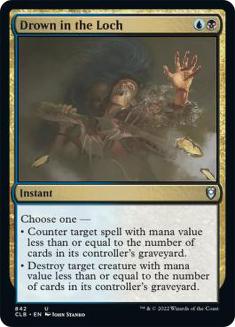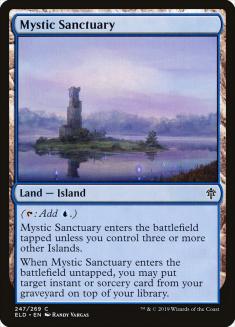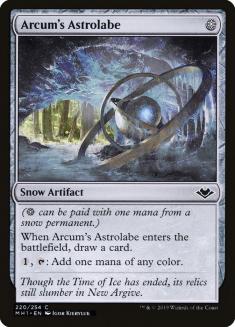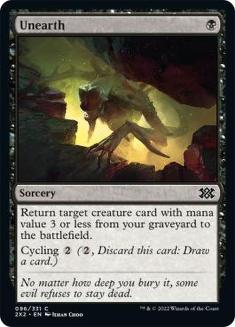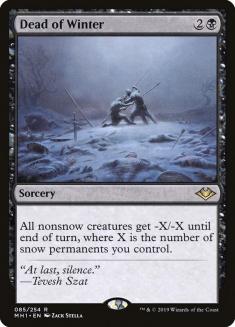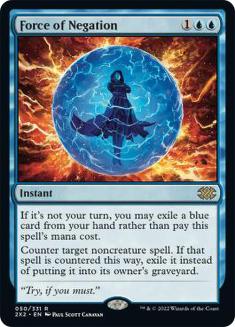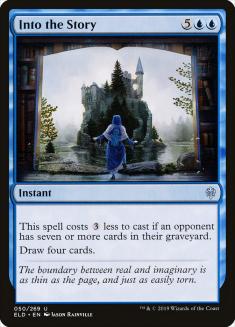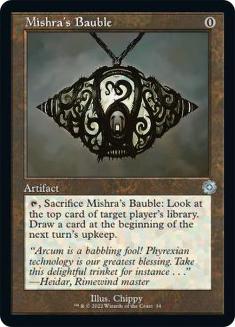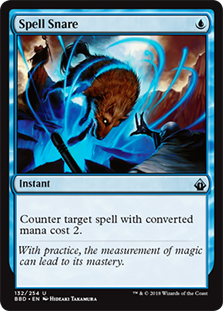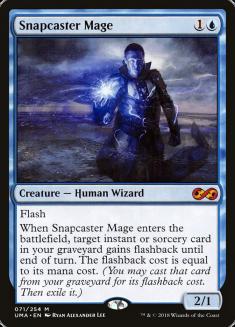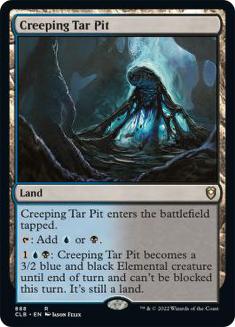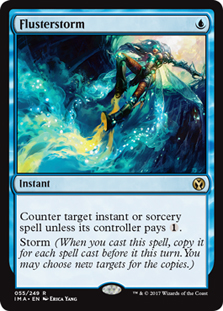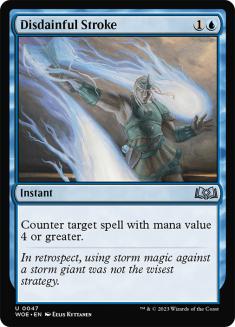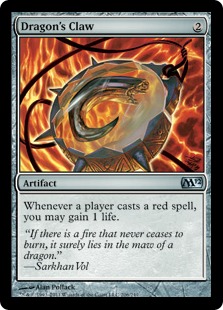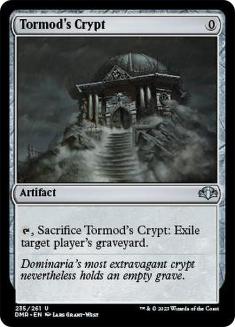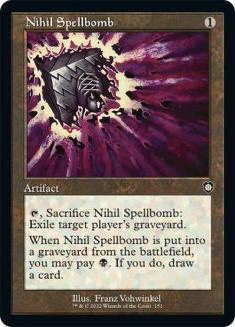Control hasn’t been able to exist in Modern in its purest form. Neither the counterspells nor the card drawing is potent enough to completely take over a game. There are also cards like Ulamog, the Ceaseless Hunger and Field of the Dead that make those strategies irrelevant.
With the help of Lurrus of the Dream-Den and some recent prints, control is not only viable in Modern, it’s also the best deck!
Together, these cards form the backbone of numerous controlling shells in Modern, although they have typically been supplemented by some sort of gratuitous end-game, like Uro, Titan of Nature’s Wrath or Urza, Lord High Artificer.
The best control decks are able to compartmentalize their win conditions in order to have as many reactive elements as possible. Lurrus of the Dream-Den lives in your sideboard and you’re able to access it whenever you want. It doesn’t get much more compartmentalized than that.
Not only is Lurrus the eighth card in your opening hand, it’s a powerful engine alongside Mishra’s Bauble and an incredible end-game with Snapcaster Mage. It even has lifelink to keep you out of burn range. If you’re drawing two or more cards per turn, a 3/2 body is more than enough of a clock to win the game thanks to your wall of counterspells.
I took what other people were doing, cut the nonsense, solidified the controlling aspects of the deck, and accidentally broke Modern.
Here’s my updated list, which is much, much better than the list I originally 5-0’ed with.
Creatures (3)
Lands (22)
Spells (35)

You likely believe that something like this is the best shell for Lurrus in a control deck but I’m going to argue that it’s the best Lurrus deck, period. Keep in mind that a statement like that is heavily dependent on the metagame and could easily change, although I don’t see that happening anytime soon.
In theory, Lurrus should be stronger in a proactive deck but I haven’t found that to be the case. Lurrus will reward you for being able to recast threats and keep up the pressure. It’s also a three-mana sorcery-speed card, which makes it difficult to be reactive and still cast Lurrus early. As it turns out, the answers are stronger than the threats. I’m not excited about Tarmogoyf, Death’s Shadow, or Ice-Fang Coatl in a format that’s trying to grind with Lurrus or ignore combat altogether.
The argument that Lurrus isn’t good in a deck with Cryptic Command and other expensive instants is mostly irrelevant. If you have Cryptic Command or some other form of interaction and you’d prefer to keep mana open, keep doing that until you can cast Lurrus with counterspell backup or until you’re out of resources.
You basically won’t cast Lurrus until you can protect it, you have nothing else to do, or you’re in dire straits. Given how much interaction the deck has, you’re rarely in the latter position. Lurrus is just as strong in a deck like this as it is in something like Burn or Jund.
I borrowed much of Sam Black Drown in the Loch control deck. You typically start by Thought Scouring your opponent, which enables early Drown in the Lochs as Counterspell / Doom Blade split cards. If you’re playing a control deck, that’s basically the best sort of card you could hope for. Mystic Sanctuary ties everything together because it allows you to recur whatever answer you need at the time. In most cases, that means having a steady string of counterspells and running your opponent out of threats.
I started with a copy of Into the Story. While it was powerful, it was very poor against graveyard hate and likely worse than a Cryptic Command. Thirst for Knowledge would be suitable given all the artifacts but that might be worse than another Archmage’s Charm. We live in a world where the counterspells happen to be protection and card drawing and I suppose we should be thankful for that. Jace, the Mind Sculptor is another option, but again, it’s likely a worse choice than either of the modal counterspells.
I would strongly argue that the maindeck has the strongest counterspell options available. You can make small tweaks, such as shaving a Spell Snare or adding another Archmage’s Charm, but the package will mostly stay intact.
The tricks with Mishra’s Bauble are numerous. One of the most common uses is pairing the Bauble look with a fetchland to prevent you from drawing something unwanted. Zero-mana filtering is incredible when you’re searching for that Turn 1 Fatal Push or Spell Snare.
Returning a card like Drown in the Loch or Cryptic Command to the top of your deck with Mystic Sanctuary and then drawing it on your opponent’s turn with the Bauble trigger is delightful.
In the later stages of the game, your opponent will likely be hellbent and you’ll have to decide whether you want to take the shields down to cast Lurrus. Most of the time, that’s greedy, but Mishra’s Bauble can help by showing if the coast is clear or not. Using Thought Scour to clear a powerful draw step for my opponent has also come up.
Keeping a Mishra’s Bauble on the battlefield in order to protect your hand from discard is quickly becoming more relevant as the format shifts toward Lurrus pseudo-mirrors. It seems small, but it means your opponent lacks the information on your hand and makes it less likely for them to clear out your counterspell and resolve their big threat. You can often crack a Bauble, cast a couple of cantrips, and have a fresh hand full of answers, meaning it’s very difficult to put you away.
With Lurrus taking over Modern, Spell Snare has become incredible again. Decks are forced to lower their mana curves and play the most powerful cheap threats, which increases Spell Snare’s hit-rate. It’s even less likely that you’ll run into a matchup where Spell Snare isn’t live.
Some amount of discard would be reasonable but it tends to be poor against opposing Lurrus decks since their best card is hiding in exile. That said, you’ll still want to hit their Snapcaster Mage or Kolaghan’s Command. The presence of Lurrus doesn’t mean that all interaction is useless but counterspells are obviously better against Lurrus itself.
Does Arcum’s Astrolabe do enough in this deck? Honestly, I’m not sure myself. The mana costs on Archmage’s Charm, Cryptic Command, and Lurrus are prohibitive and I don’t want to fetch multiple Watery Graves each game. Field of Ruin is a card I’d like to play in a metagame that has a nonzero amount of big mana but it could easily be cut from the deck. Astrolabe mostly lets you freeroll it, though.
There are situations where you Thought Scour an Astrolabe away, which gives you something to do with Lurrus later, but it’s rare that you don’t have a Mishra’s Bauble or Snapcaster Mage you’d rather cast instead.
Dead of Winter and Engineered Explosives are powerful sideboard sweepers and Astrolabe helps with both of those. Having more cantrips makes Mystic Sanctuary stronger because it’s more likely you’re able to immediately draw into the answer.
Overall, Astrolabe fixes your mana and empowers your sweepers. It’s not much but I think it’s enough. Shaving a copy is completely reasonable, though, especially if you want another Opt or removal spell for Snapcaster Mage.
Even though Snapcaster Mage is basically a sacred cow in control decks, you don’t have to play four copies. This deck spends a significant amount of slots on artifacts, so there are plenty of times where Snapcaster Mage won’t have a plethora of options. Running three copies has felt correct, especially with Mystic Sanctuary and some clunkier cards in the deck. I understand the urge to play four copies but it’s probably wrong, at least in this version.
The singleton Unearth is probably the best card in the deck. It allows you to keep your engine going thanks to Snapcaster Mage or Mystic Sanctuary, even if your opponent manages to kill your Lurrus and you haven’t grinded them out yet. In order for that to matter, you have to find the Unearth first, but it’s only going to matter in longer games where you have plenty of time to deposit it into your graveyard with Thought Scour.
One of the most common questions in response to my tweet was about how I actually win the game. In short, very easily. Snapcaster Mage beatdown is a strategy that’s as old as Innistrad, even without Lightning Bolt for extra closing power.
Lurrus is a fine clock and there’s plenty of hard countermagic to ensure you get the extra turns you need to actually end the game. If your countermagic were all Remands and Spell Pierces, eventually your opponent would be able to slip something through the cracks, but that isn’t the case here. With Lurrus giving you an engine and Mystic Sanctuary providing its own end-game, you don’t need any help.
Something like Creeping Tar Pit might seem like it has a low opportunity cost but it doesn’t interact favorably with Mystic Sanctuary, so it’s not something I’m interested in. Some players have tried cards like Thing in the Ice to handle Burn, but it’s not necessary if you mulligan appropriately. Hard countermagic is very good against them, as long as you can stop their early threats.
Mishra’s Bauble is clearly the best thing to be doing with Lurrus but Engineered Explosives is powerful too. Unless you’re taking out multiple permanents at once, Engineered Explosives is always trading down on mana. You don’t want to draw multiples because of how clunky it is but having more options for Lurrus increases its flexibility. It also gives Dimir an answer to artifacts and enchantments that it would otherwise have difficulty removing.
Only two colors might seem limited, but Arcum’s Astrolabe easily fixes that. After sideboarding, your opponents will bring in graveyard hate like Rest in Peace, which Explosives can easily handle. The versatility is nice, even if it isn’t the most impressive card.
The Sideboard
You need to prepare for Lurrus Burn, Lurrus Midrange / Control, creature decks, big mana, graveyard decks, and stack-based combo. When the format is distilled into buckets, it’s much easier to see where you should be devoting your sideboard slots. Overall, I want some additional removal, disruption, and graveyard hate. You don’t need much more than that.
Our counterspell options are nearly limitless and I could see playing any mix of Force of Negation, Dispel, Flusterstorm, Mystical Dispute, Ceremonious Rejection, or Disdainful Stroke. Thoughtseize could also fall under that category. Given the format, I’m happiest with Flusterstorm and Disdainful Stroke, although that could easily change.
I originally had Dispel and Ceremonious Rejection but the format is slightly wider than I thought it was. Flusterstorm catches sorceries like Neoform and Hour of Promise while mostly accomplishing the same thing as Dispel, except in rare scenarios. Disdainful Stroke might be worse than Ceremonious Rejection because I’m mainly looking for cheap interaction, but obviously Stroke covers far more bases.
My (shoddy) plan against big mana involved Rain of Tears and Surgical Extraction, but completely walling them with counterspells is a stronger plan. If you expect more Eldrazi Tron or Hardened Scales and less Mono-Green Tron, I recommend Ceremonious Rejection. Stroke (and Dispel) happen to be better against Amulet Titan.
You could make the argument that Dragon’s Claw has synergy with Lurrus but that’s probably too little and too late against Burn. Meanwhile, Collective Brutality is quite good against opposing Lurrus decks because you get to kill their Lurrus and hopefully their Kolaghan’s Command or Unearth that they will use to bring it back.
In many matchups, Drown in the Loch is imperative, which is why I didn’t originally play things like Nihil Spellbomb or Tormod’s Crypt. Should you move away from Drown in the Loch, maindeck Nihil Spellbomb would be incredible right now.
Graveyard hate would be helpful in some of the midrange mirrors to fight Snapcaster Mage, Kolaghan’s Command, or Uro, but it’s not necessary. You really only need it against decks like Dredge, and if you don’t have it there, you’ll likely lose. Given that, forgoing Surgical Extraction entirely for Tormod’s Crypt makes sense. However, there’s merit to playing Surgical Extraction against big mana and trying to tag a Tron land or Primeval Titan.
Sideboarding itself tends to be straightforward. Against big mana, you’re cutting spot removal. Against creature decks, you’ll often ditch some of the clunkier cards like Archmage’s Charm, unless they’re particularly good in the matchup.
The only non-obvious thing I do is shave cantrips against Burn. Your early turns are spent interacting with your opponent and they’re a huge detriment against Eidolon of the Great Revel.
Other Options
If you want to add red mana for Seal of Fire and Kolaghan’s Command or want to cut Drown in the Loch and play Nihil Spellbomb, I’d recommend something like this.
Creatures (3)
Lands (22)
Spells (35)

This version is a worse control deck and a better midrange deck. You won’t necessarily be able to take full control of a game but your answers are more diverse in general. Kolaghan’s Command makes grinding in pseudo-mirrors easier and gives you more game against artifacts, and Seal of Fire means Lurrus can help you stabilize against creature decks.
Obviously the manabase is worse but you rarely feel it unless you’re playing against Burn specifically. Having more one-mana removal will help you there but I’d rather be on the version with clean mana and Drown in the Loch in that matchup.
Kolaghan’s Command is certainly more versatile than Unearth and tends to be incredibly annoying for your opponent to break up. In Grixis, your recursion chain is endless.



